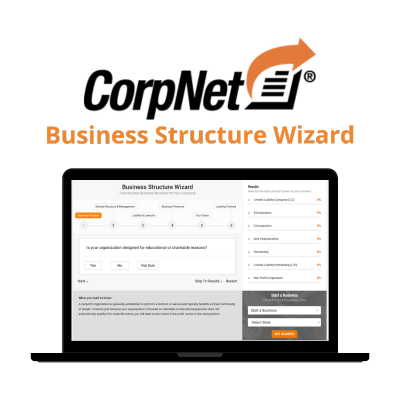You have much to think about and many questions to answer when starting a business. One of the most fundamental considerations is what type of business structure is right for you. Often, new small businesses choose to operate as a sole proprietorship or general partnership. Would either be a good fit for you? As you compare the sole proprietorship vs. partnership you’ll have lots of questions. In this article, I’ll share information about the similarities and differences between the two business structures and some thoughts about other business entity types to consider. This information should help you settle the sole proprietorship vs. partnership debate, so you select the best entity for your new business.
An Overview of the Two Business Entities
What is a Sole Proprietorship?
A sole proprietorship is an unincorporated business entity formed by either an individual business owner (or a married couple—or sometimes dependents). In a sole proprietorship, the business and the owner are considered the same legal and tax-paying entity. There is no separation between the business and its owner. By default, if an entrepreneur does not file business formation documents to register the company with the state, it is by default considered a sole proprietorship. Sole proprietors own all of the business’s assets and profits. Likewise, they are wholly responsible for all of the business’s liabilities and debts.
What is a Partnership?
A partnership (also known as a “general partnership”) is when two or more people operate a business that is not officially registered as an entity with the state. In a partnership, there is no distinction between the business and its owners. The owners and the business are considered the same legal and tax-paying entity. Individuals in a partnership share legal, financial, and management responsibilities for the business. Partnerships usually have a partnership agreement that spells out the division of ownership and duties among the business owners.
Similarities and Differences Between Sole Proprietorships and Partnerships
Let’s take a look at some of the key areas where sole proprietorships and partnerships have similarities and differences.
Ownership
- Sole Proprietorship Ownership – An individual (or sometimes a married couple or an individual and a dependent) is the sole owner of a sole proprietorship. The owner has full responsibility for all of the business’s assets, profits, and losses.
- Partnership Ownership – In a general partnership, all business owners share profits, losses, assets, debts, and management responsibilities equally. However, the business’s partnership agreement may be used to modify ownership allocation among partners.
Liability
- Sole Proprietorship Liability – Operating as a sole proprietorship provides no personal liability protection for the business owner. The owner is personally responsible for all of the business’s liabilities, putting the owner’s personal assets at risk. Many consider this the most significant disadvantage of running a business as a sole proprietor. If the business cannot pay its debts, creditors may go after the proprietor’s personal assets (such as home, personal bank accounts, cars, retirement funds, etc.) to collect on what’s owed to them. Likewise, if someone sues the sole proprietorship, it’s the same as suing the owner. Therefore, the owner’s personal assets are at risk of being taken to satisfy judgments by the court. While personal liability insurance may offer some protection for claims involving injury, property damage, and unintentional professional mistakes that cause harm, it usually does not protect the business owner against creditors’ claims.
- Partnership Liability – As with a sole proprietorship, the lack of personal liability protection is considered by many people to be the biggest drawback of operating as a general partnership. Moreover, all general partners are liable for any acts, legal wrongdoing, or debts incurred by any of the business partners. The personal assets of all partners are at risk of being taken to satisfy the business’s debts and legal judgments. Note that there are alternate business structures that do offer some personal liability protection for business owners. I’ll talk briefly about them later in this article.
Taxes
- Sole Proprietorship Taxes – Sole proprietorships are pass-through tax entities. This means that all income or losses pass through to the owner as personal income. For some entrepreneurs, having profit and loss flow through to their personal income tax returns and be taxed at the applicable individual tax rates is beneficial. It avoids the double taxation that occurs with corporations (whereby income is taxed once at the corporate level, and then the owner’s income is taxed at the personal level). For others, it may not be. Sole proprietors must pay self-employment taxes on all of the business’s profits (they don’t receive wages or salaries through payroll, so all profits are considered personal income). That 12.4 percent Social Security tax and 2.9 percent Medicare tax can add up, so it’s important to talk with an accountant or tax advisor to determine whether a sole proprietorship’s tax structure will be advantageous.
- Partnership Taxes – Like sole proprietorships, partnerships also receive pass-through tax treatment. Partnerships must provide information about the business’s income and expenses as a whole. Also, each partner must report and pay taxes via their personal income tax returns on their share of the partnership’s profits or losses. Like in a sole proprietorship, general partners do not get paid via payroll, so they must pay self-employment taxes on all of their income from the business.
Read More About Payroll: What is Payroll?
How to Start a Sole Proprietorship
Starting a sole proprietorship comes with less formality than forming registered entities with the state. Still, requirements vary depending on the type of business and where it’s located. Below I’ve listed the basic considerations involved in the process. It’s wise to research what’s required by the state and local government agencies that handle matters related to starting and running a business in your area.
1. Business Formation Paperwork
Starting a sole proprietorship requires no legal paperwork to register the business with the state. If a business owner takes no steps to establish a formal business entity (such as a limited liability company or corporation), a business operated by an individual (or married couple) is automatically considered a sole proprietorship.
2. Business Name Registration
Sole proprietors who do not want to use their legal personal name in their business name can use a fictitious name (trade name) if they file a DBA (Doing Business As). The DBA must be filed with the state or the county clerk—depending on the business’s location.
For example, if Josephine Giardo wants to market her business by the name “Josephine’s Yoga Retreat” rather than “Josephine Giardo Yoga Studio,” she would need to file a DBA for the name that doesn’t include her full first and last name.
Many states also require that businesses have their fictitious name published in one or more approved newspapers or other publications in the county where it was filed.
Fictitious names may need to be renewed, so it’s important to verify the county and state requirements.
3. Business Licenses and Permits
Depending on the type of business and location, there may be licenses and permits required at the federal, state, or local level to operate the business legally.
Through CorpNet’s Business License Service Packages, sole proprietors can have us identify the specific requirements, help prepare the applications, or even obtain all of the required licenses and permits for them.
4. Employer Identification Number
If a sole proprietorship hires employees, it must obtain an Employer Identification (EIN). An EIN is a nine-digit federal tax ID number issued by the IRS. Businesses that hire employees (or that become an LLC or corporation) must have an EIN. Often, banks will also require an EIN before opening a business bank account. Note that sole proprietorships that hire employees will have other formalities and reporting requirements to fulfill.
5. Ongoing Business Compliance
The sole proprietorship business structure has minimal oversight and formalities. Unlike other business entity types, they do not risk losing personal liability protection because they never had it to begin with. However, to operate their businesses legally, they must renew licenses and permits, and DBAs as required by law. They must also report and pay taxes. And they must follow any other rules and regulations set forth by the local, state, and federal authorities for engaging in their particular business activities.
How to Start a Partnership
Starting a partnership comes with less formality than forming registered entities with the state. Still, requirements vary depending on the type of business and where it’s located. Below I’ve listed the basic considerations involved in the process. It’s wise to research what’s required by the state and local government agencies that handle matters related to starting and running a business in your area.
1. Business Formation Paperwork
Generally, no state registration paperwork is required to form a general partnership since it’s not considered a separate entity from its owners. However, states’ rules vary, so it’s critical to check with the state’s Secretary of State office to determine what’s needed.
Whether the state requires it or not, a partnership agreement created with the assistance of an attorney is recommended to lay out all of the rights and responsibilities of business partners.
A partnership agreement spells out the relationship between the partnership’s owners and how the business should be managed. The elements included will depend on the situation. Generally, a basic partnership agreement will address:
- Business Name
- Contributions – Each partner’s stake in the formation and ongoing finances of the business
- Distributions – How will profits be split between partners
- Ownership – Explanation of what happens if:
- the business is sold
- a partner wants to leave
- a partner wants to buy out another partner
- other ownership issue arises
- Decision Making – How strategic and day-to-day decisions should be made and who has the final say
- Disputes – How disagreements among partners should be resolved
- Critical Developments – Describing what actions should be taken if:
- a partner gets sick or dies
- how the business will be evaluated (and what is the split) in the event of a buy-out offer
- provisions for the retirement of partners
- description of circumstances that call for modification of the partnership agreement
2. Business Name Registration
When a partnership’s owners do not want to include the last names of all of the partners in the business name, then the business must file a DBA. As I mentioned above, registering a fictitious name will be required at the county or state level.
Before filing a DBA, consider doing a corporate name search to make sure the name is available. A sole proprietorship or partnership (unincorporated entities) may be granted permission to use a fictitious name that’s being used as the business name of an LLC or corporation in the state. However, if the sole proprietor or partners decide to form an LLC or incorporate the business, the state may deny their request to use the name because another registered entity has already claimed it.
Keep in mind that registering a DBA does not provide any legal protection of the company name. Its purpose is to disclose to the public the individual, people, or entity operating the company under the assumed name. This helps protect potential customers, vendors, and others from doing business with unscrupulous owners attempting to hide their real identity. If a sole proprietorship or general partnership wants to obtain exclusive rights to use its DBA, it must register it as a trademark through the USPTO (U.S. Patent and Trademark Office).
3. Business Licenses and Permits
Depending on the type of business and location, there may be licenses and permits required at the federal, state, or local level to operate the business legally. Through CorpNet’s Business License Service Packages, partnerships can have us identify the specific requirements, help prepare the applications, or even obtain all of the required licenses and permits for them.
4. Employer Identification Number
If a partnership hires employees, it must obtain an Employer Identification (EIN). An EIN is a nine-digit federal tax ID number issued by the IRS. Businesses that hire employees (or that become an LLC or corporation) must have an EIN. Often, banks will also require an EIN before opening a business bank account. Note that partnerships that hire employees will have other formalities and reporting requirements to fulfill.
5. Ongoing Business Compliance
The partnership business structure has minimal oversight and formalities. Unlike other business entity types, they do not risk losing personal liability protection because they never had it to begin with. However, to operate their businesses legally, a partnership must renew licenses and permits, and DBAs as required by law. A partnership must also report and pay taxes. And they must follow any other rules and regulations set forth by the local, state, and federal authorities for engaging in their particular business activities.
Set Up Your Business for Success With CorpNet’s Help!
Whether you choose to move forward as a sole proprietorship or partnership, you can count on CorpNet to help you through the process. Our filing experts have helped tens of thousands of business owners form LLCs, file DBAs, apply for EINs, register trademarks, apply for business licenses and permits, and submit their state compliance filings accurately and on time.
It can be challenging to track everything, so it’s helpful to speak with an attorney and accountant or tax advisor for insight. CorpNet’s Compliance Portal also provides a way to monitor many compliance requirements and due dates.

Choosing a business structure can be a tough decision for the new business owner. CorpNet wants to make the process easier.
This free, online tool helps small business owners navigate the process of picking the right business structure for their new business.





